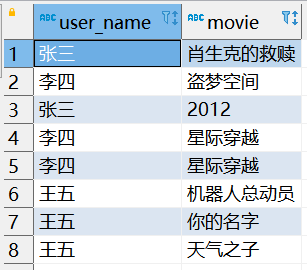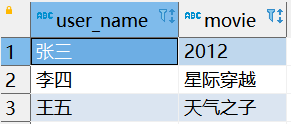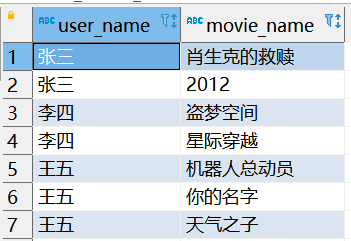1.两个日期相减精确到秒: 1 2 3 4 5 select unix_timestamp('2022-12-22 14:00:00') - unix_timestamp('2022-12-22 13:00:00') _c0 3600
如果是年月日和时分秒两个string类型拼起来即:
1 unix_timestamp(concat(trim(wc.operatedate ),' ', trim(wc.operatetime))) - unix_timestamp(concat(trim(wc.receivedate ),' ', trim(wc.receivetime))) operating_duration
2.将用字符串拼起来的时间转换为timestamp类型以插入表(字段建表给的timestamp类型) 1 from_unixtime(to_unix_timestamp(concat(trim(wrb.lastoperatedate),' ', trim(wrb.lastoperatetime)),'yyyy-MM-dd HH:mm:ss'))
3.获取当前UNIX时间戳函数: unix_timestamp 1 2 3 4 5 6 7 8 9 10 11 12 13 语法: unix_timestamp() 返回值: bigint 说明: 获得当前时区的 UNIX 时间戳 hive> select unix_timestamp() from tableName; 1616906976 语法: unix_timestamp(string date) 说明: 返回指定日期格式的时间戳 注意: 如果后面只有date参数,date的形式必须为'yyyy-MM-dd HH:mm:ss'的形式。 hive (default)> select unix_timestamp('2020-05-01'); NULL hive (default)> select unix_timestamp('2020-05-01 00:00:00'); 1464710400
4.UNIX 时间戳转日期函数: from_unixtime 1 2 3 4 5 6 7 8 语法: from_unixtime(bigint unixtime[, string format]) 返回值: string 说明: 转化 UNIX 时间戳(从 1970-01-01 00:00:00 UTC 到指定时间的秒数)到当前时区的时间格式 hive> select from_unixtime(1616906976,'yyyyMMdd') 20210328 hive> select from_unixtime(unix_timestamp(),'yyyy-MM-dd HH:mm:ss') 2023-01-04 03:39:55
(1).3和4混合使用:
1 2 3 hive> select from_unixtime(unix_timestamp(sua.apply_date),'yyyy-MM-dd HH:mm:ss') 其中sua.apply_date是string格式的年月日时分秒毫秒 返回结果:
(2).将yyyyMMdd格式的字符串转换为yyyy-MM-dd的格式的日期类型字段
1 2 3 hive>select to_date(from_unixtime(UNIX_TIMESTAMP(work_date_str,'yyyyMMdd'))) work_date 其中: work_date_str为'20220801' 结果: work_date:2022-08-01
1 2 3 4 5 6 7 8 将日期格式化为:2020-05-01和2020-05 返回类型:string hive (default)> select date_format('2020-05-01 12:00:00','yyyy-MM-dd'); _c0 2020-05-01 hive (default)> select date_format('2020-05-01 12:00:00','yyyy-MM'); _c0 2020-05
场景(1)
1 2 3 case when dayofmonth(work_date) > 25 then substr(add_months(date_format(work_date,'yyyy-MM-dd'),1),1,7) else date_format(work_date,'yyyy-MM') end as r_month, --月份
6.字符串转日期函数,默认转为yyyy-MM-dd格式: to_date(string date) 1 2 3 4 5 6 7 8 9 10 11 12 13 14 当前时间转为日期格式 hive (default)> select to_date(current_timestamp); 注:current_timestamp:2023-01-04 01:09:18.383 _c0 2023-01-04 hive (default)> select to_date('2020-05-01 00:00:00') ; 2020-05-01 hive (default)> select to_date('2020-05-01'); 2020-05-01 注意:参数必须是yyyy-MM-dd或yyyy-MM-dd HH:mm:ss格式,如果是yyyy-MM,则为null hive (default)> select to_date('2016-09'); --有问题,结果为null
7.日期加法函数: date_add (date,number) 1 2 3 4 5 6 7 8 9 将日期增加或减少4天; hive (default)> select date_add('2019-05-09',4); _c0 2019-05-13 Time taken: 0.034 seconds, Fetched: 1 row(s) hive (default)> select date_add('2019-05-09',-4); _c0 2019-05-05 Time taken: 0.049 seconds, Fetched: 1 row(s)
8.日期减法函数: date_sub (date,number) 1 2 3 4 5 6 7 8 9 将日期增加或减少4天 hive (default)> select date_sub('2019-05-09',4); _c0 2019-05-05 Time taken: 0.04 seconds, Fetched: 1 row(s) hive (default)> select date_sub('2019-05-09',-4); _c0 2019-05-13 Time taken: 0.058 seconds, Fetched: 1 row(s)
注: 7、8一般选择其一即可。
9.取该日期的下一个周几的日期: next_day (date,dayofweek) 星期一到星期日的英文
(Monday,Tuesday、Wednesday、Thursday、Friday、Saturday、Sunday)
1 2 3 4 取5.1后的下一个周五 hive (default)> select next_day('2020-05-01',"Fri"); _c0 2020-05-08
10.取当月的最后一天日期: last_day(date) 1 2 3 4 5 6 7 取5月的最后一天日期 hive (default)> select last_day('2020-05-01'); _c0 2020-05-31 hive (default)> select last_day('2020-04-01'); _c0 2020-04-30
11.日期比较函数,第一个日期减去第二个时期数字,为正,则前者大于后者,为负,则前者小于后者; datediff(date1,date2) 1 2 3 4 比较5月1日和5月5日的大小 hive (default)> select datediff('2020-05-01','2020-05-05'); _c0 -4
12.查询该日期在本月的第多少天: dayofmonth (date) 1 2 3 4 5月6号在五月是第多少天 hive (default)> select dayofmonth('2020-05-06'); _c0 6
13.获取当前日期: current_date 1 2 3 hive (default)> select current_date; _c0 2020-05-14
14.获取当前时间: current_timestamp 1 2 3 hive (default)> select current_timestamp; _c0 2020-05-14 10:26:57.613
15.日期加一个月: add_months (date,number) 1 2 3 4 2020-05-03加一个月 hive (default)> select add_months('2020-05-03',1); _c0 2020-06-03
16.返回时间的最开始年份或月份 : trunc() trunc(string date, string format) 返回时间的最开始年份或月份
返回类型:string
1 2 3 4 5 6 7 select trunc('2019-04-08','YY') --2019-01-01 _c0 2019-01-01 select trunc('2019-04-08','MM') --2019-04-01 _c0 2019-04-01
17.返回下个月第1天: trunc(add_months(current_timestamp(),1),’MM’) 1 2 3 select trunc(add_months('2020-05-03',1),'MM'); _c0 2020-06-01
18.获取时间的年份year(date)、月份month(date)、天day(date)、小时hour(time)、分钟minute(time)、秒second(time) 1 2 3 4 5 6 7 8 9 10 11 12 13 14 15 16 17 18 19 20 21 22 23 24 25 26 27 28 29 当前日期所在的年份 hive (default)> select year('2020-05-14 12:00:00'); _c0 2020 当前日期所在的月份 hive (default)> select month('2020-05-14 12:00:00'); _c0 5 获取日期中的天 hive (default)> select day('2020-05-14 12:00:00'); _c0 14 获取时间中的小时 hive (default)> select hour('2020-05-14 12:00:00'); _c0 12 获取时间中的分钟 hive (default)> select minute('2020-05-14 12:04:50'); _c0 4 获取时间中的秒 hive (default)> select second('2020-05-14 12:04:53'); _c0 53
19.日期所在年份的第多少周: weekofyear(date) 1 2 3 4 当前日期是所在年份的第多少周 hive (default)> select weekofyear(current_date); _c0 1
20.过滤多个模糊匹配的数据时: 1 2 3 4 select * from dim.dim_old_new_workflow_name where workflow_name not REGEXP '无效|测试|预算编制' 复杂写法: select * from dim.dim_old_new_workflow_name where workflow_name not like '%无效%' and workflow_name not like '%测试%' and workflow_name not like '%预算编制%'
21.字符串拼接: 1 2 3 4 5 6 7 8 9 1.concat 语法:concat(str1,str2,...) 注意事项:如果拼接的参数里面有一个为null,则结果整体返回null 2.concat_ws 语法:concat_ws(separator,str1,str2) 说明:第一个参数指定分隔符,分隔符不能为null,否则整体返回null;即时该函数后面待拼接的字符串参数存在为null也不影响整体结果,结果会跳过它继续拼接 3.hive没有group_concat()函数
22.instr函数 instr(str,substr) 返回substr在str第一次出现的位置(从1开始计数),如果substr在str中不存在则返回0
1 2 select instr('abcdefghijklmn','j') -- 10 > 10
配合substr使用:
1 2 select substr('abcdefghijklmn',instr('abcdefghijklmn','j'),3) >jkl
23.colect_list与collect_set 它们都是将分组中的某列转为一个数组返回,不同的是collect_list不去重而collect_set去重。
比如已知有以下表user_watch_movie记录部分用户在某月内看过的电影:
1 2 按用户分组,取出每个用户这个月看过的所有电影名称 select user_name,collect_list(movie) movie_array from user_watch_movie group by user_name;
但上面的查询结果有点问题,因为星际穿越太好看了,李四在第一次看完后几天又去看了一次,导致了观看列表有重复的,这时候就应该用collect_set增加去重。
1 select user_name,collect_set(movie) movie_array from user_watch_movie group by user_name;
突破group by限制
hive中,凡是在select后面没有使用到聚合函数的列都必须出现在group by后面,即select的列必须作为分组依据,但有时候想要根据A分组,然后随便取出每个组织中的一个B,运用到此例中,即:
1 select user_name,collect_list(movie)[1] movie from user_watch_movie group by user_name;
movie不是分组列,但依然能取出该列数据。
一些处理记录 1.行转列:
函数
描述
CONCAT(string A/col,string B/col…)
返回输入字符串连接后的结果,支持任意个输入字符串
CONCAT_WS(separator,str1, str2,…)
第一个参数参数间的分隔符,如果分隔符是 NULL,返回值也将为NULL。这个函数会跳过分隔符参数后的任何 NULL 和空字符串。分隔符将被加到被连接的字符串之间。
COLLECT_SET(col)
将某字段的值进行去重汇总,产生array类型字段
COLLECT_LIST(col)
函数只接受基本数据类型,它的主要作用是将某字段的值进行不去重汇总,产生array类型字段。
2.列转行(一列转多行):
Split(str, separator): 将字符串按照后面的分隔符切割,转换成字符array。
EXPLODE(col): 将hive一列中复杂的array或者map结构拆分成多行。
LATERAL VIEW
1 2 用法: LATERAL VIEW udtf(expression) tableAlias A S columnAlias
解释:lateral view用于和split, explode等UDTF一起使用,它能够将一行数据拆成多行数据,在此基础上可以对拆分后的数据进行聚合。
lateral view首先为原始表的每行调用UDTF,UDTF会把一行拆分成一或者多行,lateral view再把结果组合,产生一个支持别名表的虚拟表。
例表如下:
1 select user_name,movie_name from user_watch_movie2 lateral view explode(split(movie,',')) movie_name_tmp as movie_name
实际项目运用中的部分代码:
将存有多个id并且以逗号分割的managerstr拆分,行转列后再与id关联
1 2 3 4 5 6 7 8 9 10 11 12 13 14 15 16 17 18 19 from ods.ods_oa_hrmresource hr left join( select h.id, h.managerstr, concat_ws(',',collect_list(hr.workcode)) workcode, concat_ws(',',collect_list(hr.lastname)) lastname from (select id, managerstr, single_alias from ods.ods_oa_hrmresource lateral view explode(split(managerstr, ',')) alias as single_alias) h left join ods.ods_oa_hrmresource hr on hr.id = h.single_alias group by h.id, h.managerstr )h on hr.id = h.id
3.order by和case when联用:
例子:
有如下user表
需要安装status排序,但是排序规则是按照自定义指定的,状态4排在最前面,顺序依次为:4、2、3、6、1、0、5
1 2 3 4 5 6 7 8 9 10 select * from user order by case when status = 4 then 0 when status = 2 then 1 when status = 3 then 2 when status = 6 then 3 when status = 1 then 4 when status = 0 then 5 when status = 5 then 6 else status end
待继续更新…













